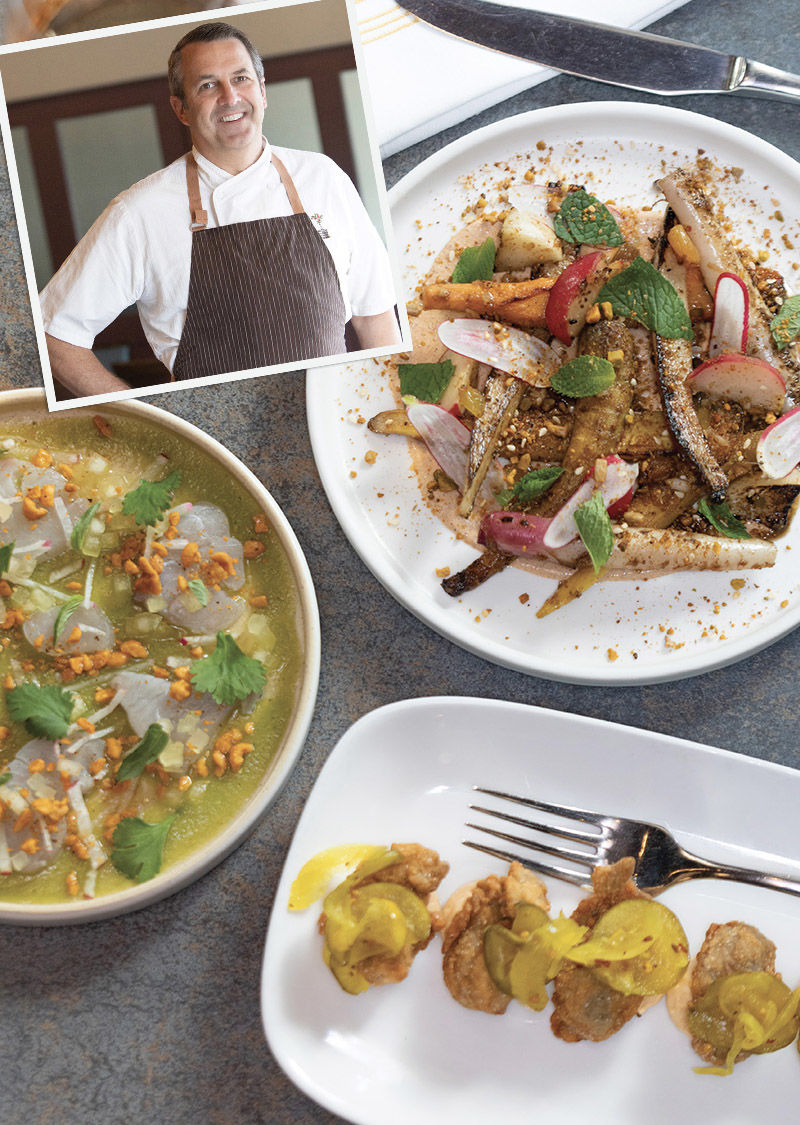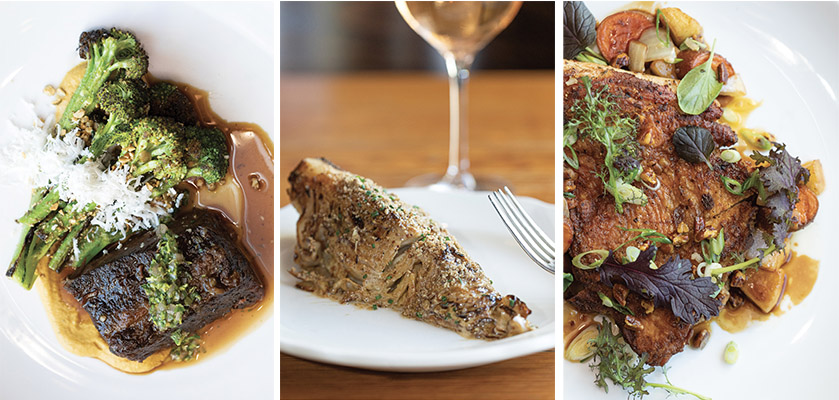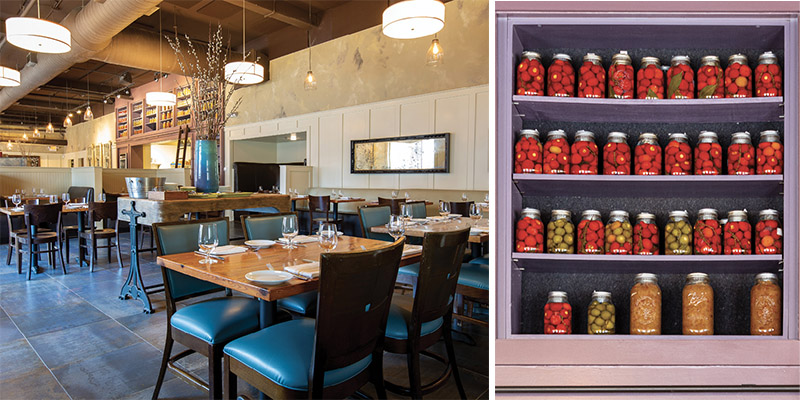4 Cannon St. - (843) 302-8825 - thegrocerycharleston.com

Flavor Medley: (Clockwise from top) Autumn roots with harissa yogurt and pistachios; cornmeal-dusted oysters, deviled egg sauce, and pickles; mackerel crudo with Granny Smiths, jalapeño, lime, and spiced peanuts; (Inset) The Thinker: Six-time James Beard nominated chef Kevin Johnson
The first thing you might notice when stepping into the 4,200-square-foot space at four Cannon Street is the pickle wall. Displayed as an anthology of selected works, accessible via a rolling library ladder, some 150 Mason jars—spotlit above an open kitchen—are arranged in a gradation of chromatic reds (cherry peppers), yellows (squash), and greens (tomatoes). The collection is more than eye-catching storage, though; these preserved vegetables signify both canon and tool kit for one of the South’s most contemplative chefs.
When Kevin Johnson opened The Grocery with his wife, Susan, in December 2011, west of King Street remained largely uncharted territory. But the Johnsons believed the former furniture warehouse could be a space to grow into, like untilled acreage. Sure enough, nearly a decade into operations, the farm-to-table restaurant belongs to a postmodern league (what followed the East Bay boom of the ’90s) that has come to define Charleston’s current culinary landscape. While Johnson launched a year after Sean Brock’s Husk, fewer gastronomes have sought out the native Virginian and his food with as much vigor—which is a shame. In ways, Johnson has quietly established himself as the quintessential contemporary Southern chef.

Variety Hour: (Left to right) Beef short rib with romesco and chimichurri; cabbage gratiné; roasted chicken with sweet potatoes and apples
No, you won’t find shrimp and grits on the menu, although there is seafood pilau—a trove of Lowcountry treasures (shrimp, clams, and billets of crisp fried fish) ensconced in field pea-studded Carolina Gold rice. The most exciting dishes though, which represent more than one-third of the menu, feature local produce, pickled and fresh, in a rotation of preparations inspired by the Mediterranean rim. Strewn atop harissa yogurt, roasted turnips and carrots are gilded with golden raisins, dill, and pistachios. Butter beans mingle with bitter roughage (escarole and radicchio) and are tempered with sweet peppers and aged provolone. There are occasional aberrations from this coastal profile, too, such as the cabbage, which leans Germanic with a rich mustard cream sauce. Conical heads of the Wakefield variety are sous vide for two hours, allowing the tender heirloom crop to retain toothsomeness—a virtue that often eludes slow-cooked brassicas.
While Johnson exalts vegetables with a kind of poetic reverence for the region’s bounty, he approaches proteins with as much study and care. The menu (divided into produce, seafood, and meat) allows for a Choose Your Own Adventure-type experience. Like-minded folks could share a variety of starters (such as the fried oysters, nestled in deviled yolks and brightened by spicy sweet pickles) and end with the wood-fired whole fish for the table. Not into sharing? That works, too. If you get the short rib, you’ll want to devour it solo. Dry-rubbed, seared, then roasted without the introduction of liquids (wine or stock is the traditional route), the beef’s flavor is distilled to its essential, meaty character while remaining so supple you can altogether ditch your knife. Texture from shards of raw butternut squash, shaved ricotta salata, chimichurri, and romesco add satisfying balance. But it is likely the chicken that will incite unexpected order-envy from your dining companions. An evolution based on Johnson’s observations from the kitchen he still mans most nights, the half or whole bird is deboned in prep (to relieve guests from the awkwardness of carving); what arrives instead is an alluring cloak of crisp skin, beneath which moist thigh and breast meat await.

(Left) Blue Note: Serene hues adorn the spacious dining room along with modern farmhouse furnishings; (Right) Preservation Hall: Pickled vegetables, a staple ingredient at The Grocery
Such attention to craft has earned Johnson multiple James Beard Award nominations and a steady patronage that eschews categorization (everyone from locals to tourists, Boomers to Gen Xers). Perhaps this wide range has also led to the noticeable lack of seasoning; barring the mains, most dishes tasted distinctly muted. Aside from salt, those Mediterranean spices begged to be amplified, which may signal an over-accommodation to, or anticipation of, the customer’s palate. But it’s also possible adjustments have already been made; from the expo station, Johnson is taking note of every subtle gesture, from salt shaker requests to the flow of the dining room.
He can see most of the action, anyway. With 110 seats in the house, he must rely on a skillful (and genial) staff to relay the rest. The space itself, which recently underwent minor renovations (tile has replaced the stained concrete floor), is similarly polished but unstuffy, outfitted with Aegean blue textiles and antique furnishings, softened with farmhouse-esque reclaimed wood and mirror decor and hand-painted signage.
Occupying nearly half the block, by all measure The Grocery is downright palatial compared to the current paradigm of intimate, if cramped, walk-in only restaurants that often demand hours-long waits. There’s nothing showy here, just like the chef himself. Maybe that’s what Southern hospitality is all about: ennobling the food, yes, but also the enduring practice of pleasing the guest—in other words, honoring the art of thoughtful reception. “Since we must eat to live,” writes M. F. K. Fisher, “we might as well do it with grace and gusto.” Many restaurants have the gusto, but what The Grocery embodies is a kind of grace that, elsewhere, is too easily forgotten.
The Draw: Superb iterations of Lowcountry vegetables; a thoughtful beverage program
The Drawback: The capacious dining room can feel quiet on slower nights
Don’t Miss: Butter bean salad, short rib, fried oysters, roasted chicken
Price: $$-$$$$